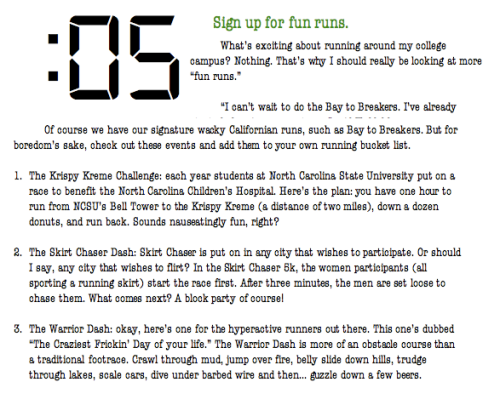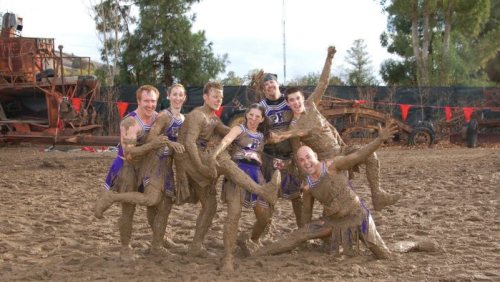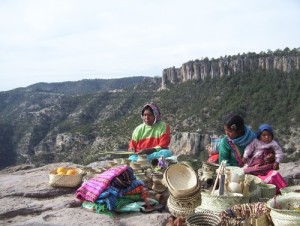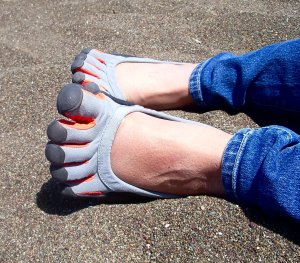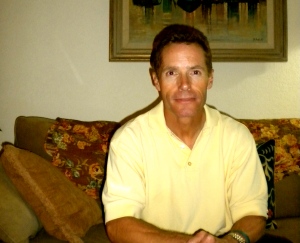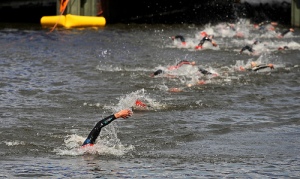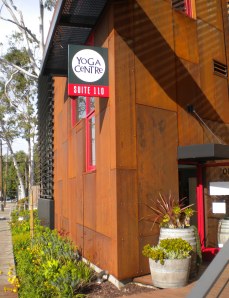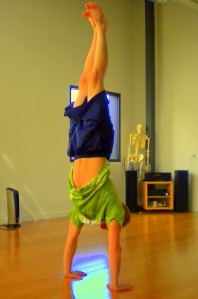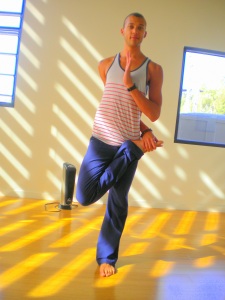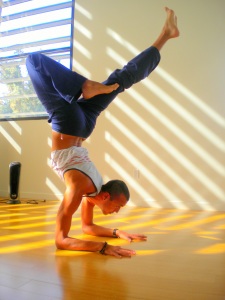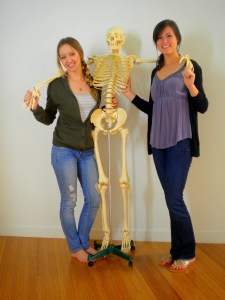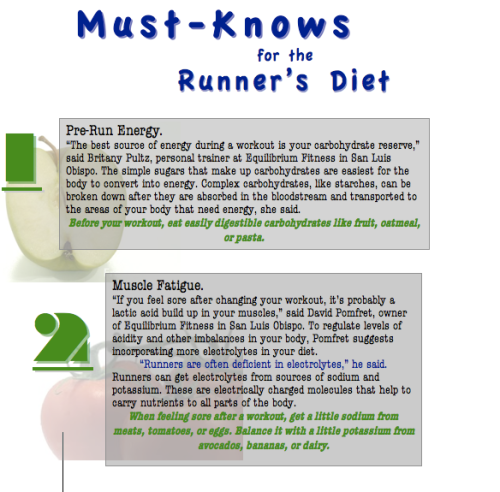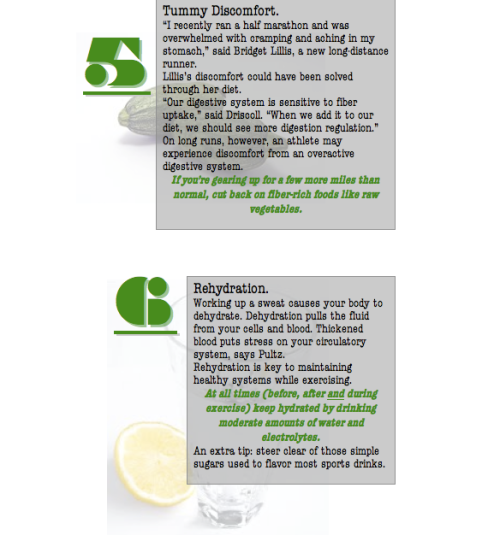I met up with the San Luis Distance Club to join them for a run. Three sets of four 400m and some good conversation. You can join the non-profit team at any time, any age. This is what partner training is all about!
Hit the track
The City to the Sea
Are We There Yet?!
It’s a problem every runner has and none want to admit.
Running can get boring.
Some days it’s hard to dig down to find the motivation to hit the alarm at 5:30 am, to pull yourself off the couch during an episode of Jersey Shore, to squeeze in a few more blocks, to get one foot to continually follow the other.
Sure, we always feel great as we wind down to a jog when home is in sight. But in mid-run, or mid-week, or mid-training program, how do we avoid boredom? How do we remind ourselves: “Oh yeah, I love this!”
Story Highlights:
- Find running friends
- Make small changes to your routine
- Keep an active mind
- Shave your groove thing
- Run and be joyful
The trick is to prevent mindless wandering. Here are few tips to do so.
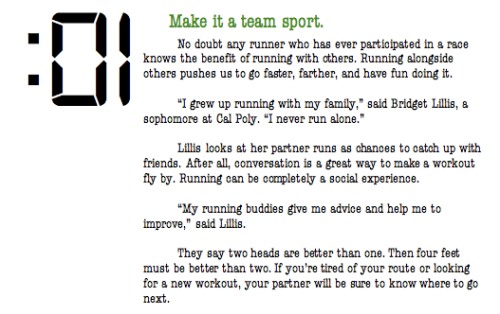 Running with partners is so important, in fact, that there are sites specially designed just to meet running partners.
Running with partners is so important, in fact, that there are sites specially designed just to meet running partners.
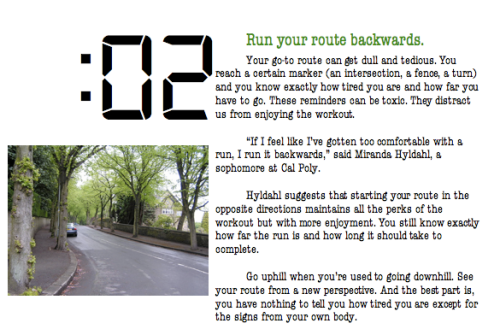
Here’s an account of a newbie runner who tried this trick and found success!
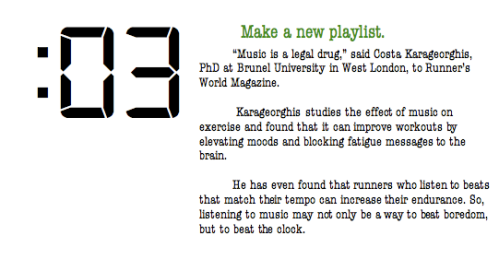 For more information on Karageorghis, click here.
For more information on Karageorghis, click here.
For a suggested playlist, click here.
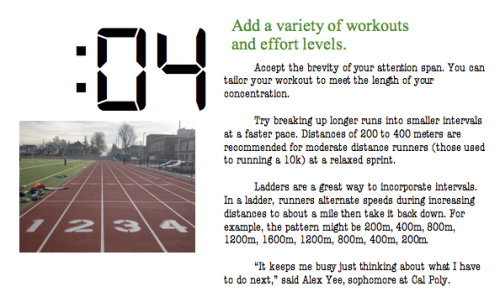 For a suggested workout, click here.
For a suggested workout, click here.
Check them out:
The Skirt Chaser Dash– You may also need one of these, a running skirt.
Why Barefoot?
Change it up with eight new routes!
Here on the Central Coast, we live in too beautiful a place to become bored with our runs. A map of eight gems in San Luis Obispo County will keep you motivated. Take these suggestions as encouragement to explore your surroundings by running through them. Each route includes a link to a map for more specific directions.
From Cayucos to Pismo, you are guaranteed never to run out of sites to see.
Posted in Uncategorized
Star Athlete: Spotlight on Jay Farrior, Superhero Dad
San Luis Obispo’s Tri-Athlete
Highlights:
- History of a nationally ranked athlete
- Advice on how to train for a triathlon
- Account of a champion’s proudest moments
San Luis Obispo local, Jay Farrior, was a nationally ranked triathlete in the 1980’s.
He has competed among legendary triathletes like Scott Tinley, Scott Molina, and Lance Armstrong (all title-holders in the U.S. Triathlon Series Championships). In addition to winning countless races throughout the United States, Farrior has won such local races as the Central Coast’s Avia Wildflower Triathlon. In 1994, Farrior was named champion of the Bud Light Triathlon Series.
“I never really thought it was hard, if that sounds weird,” says Farrior.
Competing in triathlons was a perfect fit for Farrior, who has been an athlete since grade school.
Farrior began running when he realized it was a faster way to get to school in the morning than walking. In high school, he was involved in track and cross country. It was not until after college, however, that Farrior found triathlons.
“I didn’t come from a swimming background,” said Farrior, who found strengths and weaknesses in the sport.
His swimming times were reasonable, he said. He could get out of the water at about 21 minutes, but other athletes could finish the swimming portion in as little as 17 minutes. Because the swim is the first event in a triathlon, Farrior was always behind from the start.
Luckily, Farrior is a runner at heart.
“Most swimmers aren’t runners,” said Farrior.
Swimmers may be the first to get out of the water, but they will try to conserve their strength on the bike in order to finish strong on their run in the final leg of the race.
Farrior, on the other hand, was never concerned with “not having legs when [he] got off the bike,” he said.
“If there was any one in front of me, I’d run them down,” he said.
Farrior says that triathlons were built for runners. The 10k run comes after a 1.5k swim and 40k bike.
“I would have an hour and a half to catch those guys,” said Farrior. “And it ends on my strength.”
Many of the best triathletes come from running backgrounds, said Farrior.
In the 1980’s, the sport was just reaching a bigger fan base. Farrior was a part of growing trend as he trained with a group of 20 triathletes in the Fresno area. About four of them, men and women, were nationally ranked.
The intensity of training is so time consuming that triathletes rarely get to spend time with friends and family outside of workouts. For this reason, Farrior became a part of the triathlete community of the 1980’s.
“It’s a very selfish sport,” said Farrior.
All of Farrior’s training peaked in 1987 when he competed in the U.S. Triathlon Series Championships in Hilton Head, South Carolina.
“I was in the best shape of my life, it was a culmination of an entire season,” said Farrior.
He was winning full triathlons every week for the entire summer leading up to the championships.
Though Farrior has a competitive edge that he maintains today, winning his races was never clouded by prizes.
Farrior chose to stop triathlon racing after he started his family with the birth of his first daughter, Josie.
“My dad’s past is inspiring to me,” said Josie. “One day I hope to be able to compete in a triathlon.”
Though Farrior never pushed his children into the sport, they took an interest in their father’s talent.
Josie began training to compete in Wildflower 2012 this year and took her little sister, Jackie, along for the ride.
“I don’t want to compete, but going on bike rides with my dad is just fun,” said Jackie.
Now, Farrior bikes and runs for fun. Though he has left the racing world, he has not lost his competitive personality.
He still wakes up for workouts before making it to work at 6:30 am each morning.
“Once in a while I’ll see some one along the road going faster than me and I’ll try to catch them,” said Farrior.
Advice from the Pro:
- “Don’t have a boyfriend or girlfriend.” And if you do, make sure they understand what kind of time commitment you are putting in to training.
- “If you just want to finish, it’s not too hard.” Farrior suggests one hour a day for three to four months, varying workouts of biking, swimming and running.
- “If you want to win, it’s gonna take a little more work.” To seriously compete, Farrior says triathletes must commit to biking 200 to 300, swimming 10 kilometers, and running 30 miles. “That’s got to be every week no matter what,” he said.
<span><a href=”http://soundcloud.com/hhanselman/super-hero-dad/s-7AZyF”>Super hero Dad</a> by <a href=”http://soundcloud.com/hhanselman”>hhanselman</a></span>
Yoga for Athletes
Like many athletes, runners’ bodies suffer from a physically damaging sport. No runner is immune to the tight hamstrings, the aching joints, and the stress fractures. The impact of the ankles, knees, and hips can be a harsh beating for many. So how do we get around it?
It’s a pleasure to introduce you to…
The Wonderful World of Yoga
Highlights:
- Physical Benefits
- Mental Benefits
- Philosophical Benefits
- Introduction to Yoga Instructors at the Yoga Centre, Cal Poly
- Perfect Poses for Runners
Yoga reaches us where we least expect it…
Many people have not ventured in to yoga because of the reputation it has as a relaxation exercise.
“I had fallen asleep in a yoga class I once took,” said Rocky Heron, an instructor at San Luis Obispo’s Yoga Centre.
When Heron could not afford a gym membership as a student in Los Angeles, he started talking power yoga classes with a friend at a donation-based studio.
“It kicked my butt. But I left feeling clear minded and good about myself,” he said.
Heron was hooked. With seven years of practice, he now teaches all levels (including master classes) at the Yoga Centre.
Think yogis are just a bunch of lengthy rubber bands? Wrong.
Trevor Dieterle, a 5th year Liberal Arts and Engineering Studies major at Cal Poly and yoga instructor at the Yoga Centre, was brought to yoga by his mother’s fitness adventures. As a water polo player and swimmer, Dieterle wanted a hard workout.
The strength and flexibility he found in his body and the concentration he developed from the practice lead to completing 200 hours of training to become a certified instructor. Dieterle has now been practicing yoga for almost two years.
Trying out a yoga class with a friend is always a good idea.
“She made me,” said Travis Bobbitt, co-owner of the Yoga Centre.
“His mom made us,” said Jenn Bobbitt, co-owner and instructor at the Yoga Centre, and Travis’s wife.
The couple began practicing when they went to a Mother’s Day yoga class with Travis’s mom. Travis, a professional golfer since 2003, and Jenn, a gymnast since she was three years old and recently an aerial performer, bought the yoga centre in May of 2010.
Build strength, gain flexibility, lose weight…
“No matter what you do, yoga is going to make you do it better,” said Dieterie.
Dieterle’s background in swimming and water polo shares a few similarities with yoga. In particular, both yoga and water sports teach athletes to create a pace through controlling breath.
“It’s fun to come back to the pool and swim faster,” said Dieterle after spending the past two years learning yoga.
Dieterle has not lifted weights since he found yoga. His strength has increased, however, because he says practicing yoga has strengthened his muscles more evenly.
“A lot of sports are asymmetrical,” said Heron. For example, baseball players have more strength in their throwing arms and soccer players have stronger kicking feet.
Because yoga is as much a study of the body as it is an exercise, practitioners learn the biomechanics of how energy moves throughout the body. Yoga creates balance in the body in this way.
“You become a master of your own domain,” said Heron.
Yoga teaches all athletes what it feels like to be strong and flexible. The practice trains the body into sensitivity so that one will be aware of losing the balance.
Even athletes whose sport requires acute awareness, yoga brings the consciousness deeper.
“You have to have a ton of body awareness in golf,” said Travis. After discovering yoga, however, “the difference was night and day.”
Travis says that yoga is a great form of cross-training for any sport.
The total body workout that yoga offers trains the body how use each muscle, said Heron.
“Our bodies don’t come with instruction manuals. Yoga is the closes thing,” said Heron.
Heron resolved the awkwardness of his body after his growth spurt when he was younger. Dieterle has lost 25 pounds from the cardio and strength training benefits of his practice. Jenn has regained strength in her over-exhausted joints.
“Yoga creates the body for you that you’re supposed to have,” said Heron.
Work your mind…
Ujjayi breath is a practice of controlling the breath to flow with the body’s movements. In ujjayi, the breath sounds like an ocean.
Learning to focus on one’s breath and become more mindful, focused, and present is the ultimate goal of practicing yoga. Learning this focus even teaches practitioners to control the heart rate.
Heron relates yoga to “being in the zone” as football players are in a big game. Players perform better when they are not distracted by past games or even positive effects of playing well. The highest success rates come when one has found a neutral place or a focal point of concentration.
“Yoga helped with school more than anything else,” said Dieterle.
Dieterie came to his first yoga workshop after giving up on medication for his Attention Deficit Hyperactivity Disorder.
He took an Ashtanga workshop, a popular type of yoga that was originally designed to teach teenage boys to focus. Dieterle has since seen his academic work excel without medication.
When he once decided to take time off of yoga, he found his grades slipping. Dieterle has found a correlation between yoga, concentration, and clarity.
Deep stretches, deep thoughts…
“Life is better when it’s full of yoga,” said Dieterle.
“Koshas” is a Sanscrit word for sheaths or layers. It is a philosophy that the meditation of practicing yoga will bring one deeper into the body. Eventually, we pass through physical distractions, learn to regulate energy, and move to our true selves.
“You start to become more connected to how you are designed to function,” said Heron.
At the end of each yoga class at the Yoga Centre, practitioners lay in savasana, also known as a corpse pose. It’s hard to tell yourself to relax on command and lay there for five minutes, said Jenn, who has been practicing yoga for years.
With honing this intense concentration comes complete knowledge over one’s own body.
“Eventually, yoga teaches you to have control over your own well being and health,” said Jenn, suggests that we take our healthcare into our own bodies.
Yoga for runners…
Whitney, a yoga adviser at the Yoga Centre, started her practice three months ago while training for half marathons.
“My hips and knees were really falling apart and my strength was unbalanced,” said Whitney, whose body has improved since coming to the Yoga Centre.
Dieterle, Heron, and Jenn offer some advice for runners in her condition:
“The people with the tightest bodies are usually the runners and the surfers,” said Heron.
Reach for your toes!
- Janushirsana opens up the hip, lower back, and hamstring.
- Bhekasana will loosen quadriceps.
- Virasana will help with shin splints.
- Dhanurasana will give you a good stretch all the way down to your ankles.
Posted in Uncategorized
Diva and Divo
Photos by Hope Hanselman, Jan 27, 2011
Running Divas is a local athletic apparel company. Marc Genet and Aeron Arlin Genet’s line of inspirational attire embody just what it feels like to eat, breathe, and sleep running
Vodpod videos no longer available.
Posted in Uncategorized
Why We Run
A look at how runners get inspired, stay motivated, and keep running…
Posted in Uncategorized | Tags: Alex Cagwin, Ally Dahl, Andrew Ariey, Danielle Brennan, Danny Ershov, Hope Hanselman
Re-load, Re-boot, Re-fuel!
Highlights:
- Hear the nutritional skinny from physical trainers
- Choose the right meal for the right time of day
- Learn how to reduce injury
- Identify the best food for the job
Click on each tip for a closer look…
